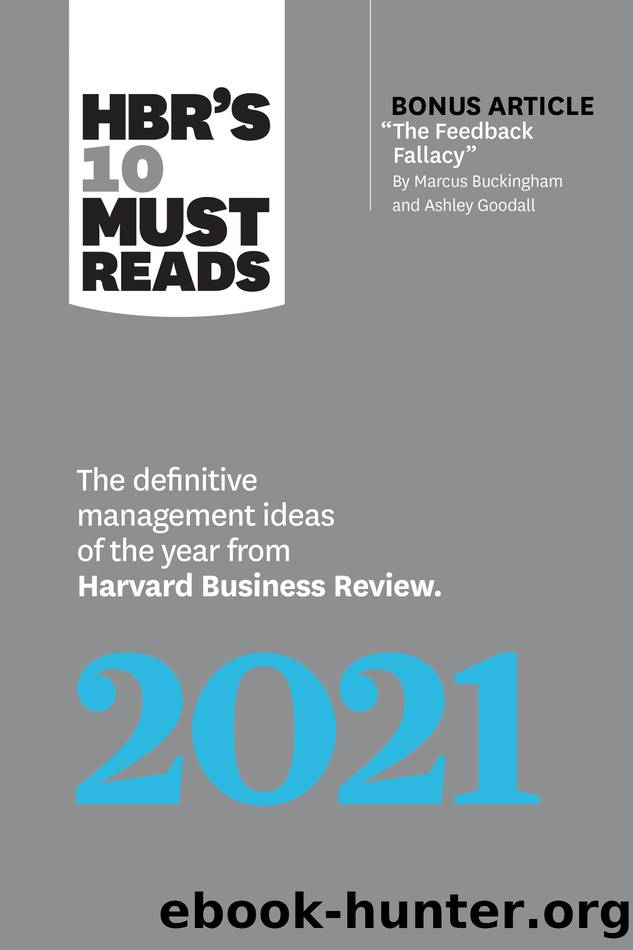HBR's 10 Must Reads 2021 by Harvard Business Review

Author:Harvard Business Review [Harvard Business Review]
Language: eng
Format: epub
ISBN: 9781647820046
Publisher: Harvard Business Review Press
Published: 2020-06-10T00:00:00+00:00
Does Data Confer Network Effects?
The answers to questions 6 and 7 will tell you whether data-enabled learning will create true network effects. When learning from one customer translates into a better experience for other customers and when that learning can be incorporated into a product fast enough to benefit its current users, customers will care about how many other people are adopting the product. The mechanism at work here is very similar to the one underlying network effects with online platforms. The difference is that platform users prefer to join bigger networks because they want more people to interact with, not because more users generate more insights that improve products.
Letâs look at Google Maps again. Drivers use it in part because they expect many others to employ it too, and the more traffic data the software gathers from them, the better its predictions on road conditions and travel times. Google Search and Adavivâs AI-based crop-management system also enjoy data-enabled network effects.
Like regular network effects, data-enabled ones can create barriers to entry. Both types of effects present a huge cold-start, or chicken-or-egg, challenge: Businesses aiming to build regular network effects need to attract some minimum number of users to get the effects started, and those aiming to achieve data-enabled network effects need some initial amount of data to start the virtuous cycle of learning.
Despite these similarities, regular network effects and data-enabled network effects have key differences, and they tend to make advantages based on the regular ones stronger. First, the cold-start problem is usually less severe with data-enabled network effects, because buying data is easier than buying customers. Often, alternative sources of data, even if not perfect, can significantly level the playing field by removing the need for a big customer base.
Second, to produce lasting data-enabled network effects, the firm has to work constantly to learn from customer data. In contrast, as Intuit cofounder Scott Cook has often said, âproducts that benefit from [regular] network effects get better while I sleep.â With regular network effects, interactions between customers (and possibly with third-party providers of complementary offerings) create value even if the platform stops innovating. Even if a new social network offered users objectively better features than Facebook does (for instance, better privacy protection), it would still have to contend with Facebookâs powerful network effectsâusers want to be on the same social platform as most other users.
Third, in many cases nearly all the benefits of learning from customer data can be achieved with relatively low numbers of customers. And in some applications (like speech recognition), dramatic improvements in AI will reduce the need for customer data to the point where the value of data-enabled learning might disappear completely. Regular network effects, on the other hand, extend further and are more resilient: An additional customer still typically enhances value for existing customers (who can interact or transact with him or her), even when the number of existing customers is already very large.
Download
This site does not store any files on its server. We only index and link to content provided by other sites. Please contact the content providers to delete copyright contents if any and email us, we'll remove relevant links or contents immediately.
The Bullet Journal Method by Ryder Carroll(1510)
Doesn't Hurt to Ask by Trey Gowdy(1400)
The Concise Laws of Human Nature by Robert Greene(1223)
The 7 Habits of Highly Effective People by Stephen R. Covey & Sean Covey(1014)
HBR's 10 Must Reads 2021 by unknow(976)
Hook Point: How to Stand Out in a 3-Second World by Brendan Kane(934)
HBR's 10 Must Reads 2021 by Harvard Business Review(877)
The Job Closer by Steve Dalton(828)
Don't Sweat the Small Stuff...and It's All Small Stuff by Richard Carlson(810)
Master of One by Jordan Raynor(809)
100 Things Successful People Do by Nigel Cumberland(800)
Primal Leadership by Daniel Goleman(781)
Amazon Unbound by Brad Stone(779)
Declutter Your Mind: A step by step guide to learn to control your thoughts, stop worrying, relieve anxiety and eliminate panic attacks and negative thinking by Mia Chandler(748)
Lives of the Stoics by Ryan Holiday & Stephen Hanselman(723)
Coders at Work: Reflections on the craft of programming by Peter Seibel(660)
The Power of 100! by Shaun King(645)
Conflicted by Ian Leslie(644)
The Mechanism of Mind by Edward De Bono(639)
